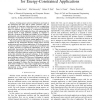Free Online Productivity Tools
i2Speak
i2Symbol
i2OCR
iTex2Img
iWeb2Print
iWeb2Shot
i2Type
iPdf2Split
iPdf2Merge
i2Bopomofo
i2Arabic
i2Style
i2Image
i2PDF
iLatex2Rtf
Sci2ools
IPSN
2007
Springer
2007
Springer
Lucid dreaming: reliable analog event detection for energy-constrained applications
— Existing sensor network architectures are based on the assumption that data will be polled. Therefore, they are not adequate for long-term battery-powered use in applications that must sense or react to events that occur at unpredictable times. In response, and motivated by a structural autonomous crack monitoring (ACM) application from civil engineering that requires bursts of high resolution sampling in response to aperiodic vibrations in buildings and bridges, we have designed, implemented, and evaluated lucid dreaming, a hardware–software technique to dramatically decrease sensor node power consumption in this and other event-driven sensing applications. This work makes the following main contributions: (1) we have identified the key mismatches between existing sensor network architectures and event-driven applications; (2) we have proposed a hardware–software technique to permit the power-efficient use of sensor networks in event-driven applications; (3) we have analytic...
Event-driven Applications | Hardware–software Technique | IPSN 2007 | Sensor Network Architectures | Sensor Networks |
| Added | 08 Jun 2010 |
| Updated | 08 Jun 2010 |
| Type | Conference |
| Year | 2007 |
| Where | IPSN |
| Authors | Sasha Jevtic, Mathew Kotowsky, Robert P. Dick, Peter A. Dinda, Charles Dowding |
Comments (0)

